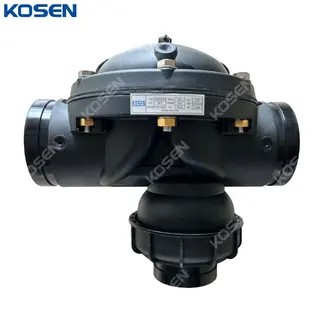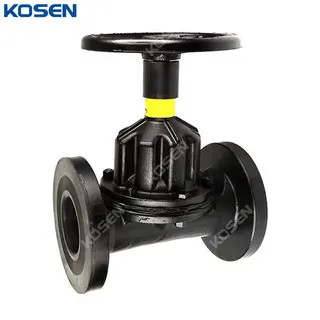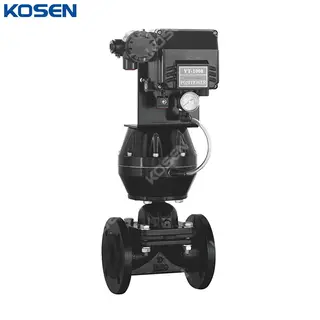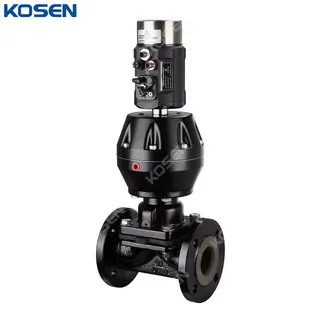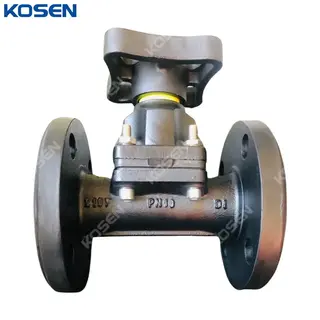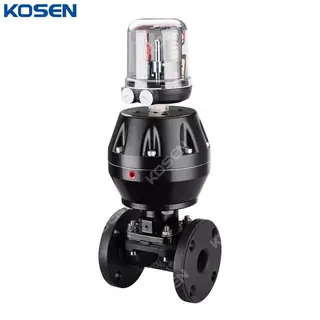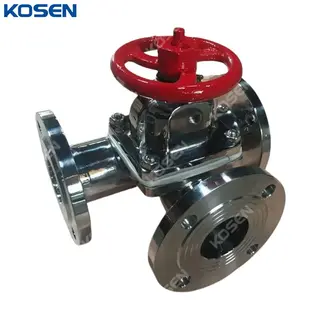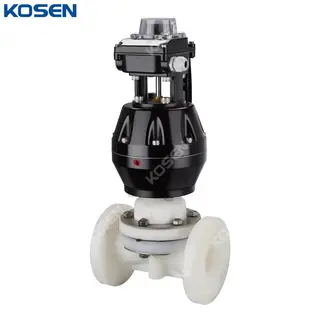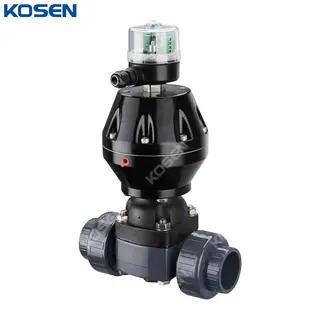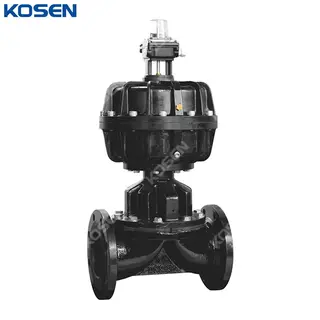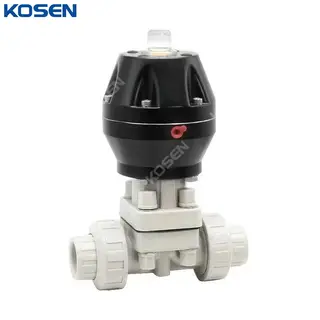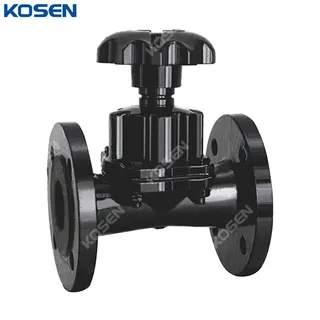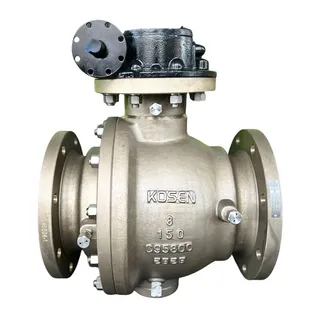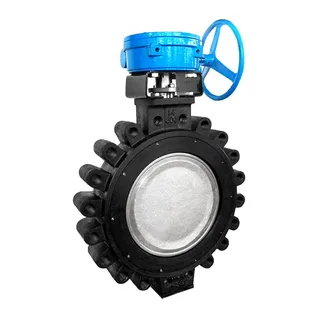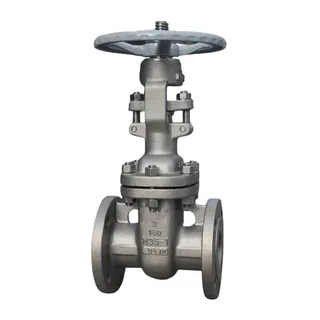Diaphragm valves are devices used to control the flow of fluids in pipelines by adjusting the opening or closing of the valve. Their unique design allows for full opening, complete closure, or any intermediate position, providing precise control over fluid velocity and pressure.
Diaphragm valves regulate flow accurately by adjusting the valve's opening status. When fully open, the flow is at its maximum; when closed, the flow is completely blocked. The valve can also be adjusted to intermediate positions to flexibly control both flow and pressure. This capability makes diaphragm valves highly efficient for fluid control in various applications.
The core structure of a diaphragm valve includes a diaphragm that effectively isolates the fluid in the pipeline from the external environment, preventing leaks. The diaphragm is typically made from corrosion-resistant, wear-resistant materials, enabling the valve to maintain stable performance when handling corrosive, high-temperature, or crystallizing fluids, ensuring reliable operation even under harsh conditions.
Diaphragm valves create a sealed space inside the valve, preventing the fluid in the pipeline from coming into contact with air, dust, or contaminants. This design significantly reduces the risk of contamination and cross-contamination, making diaphragm valves widely used in industries with high hygiene requirements, such as pharmaceuticals, food processing, and healthcare.
In addition to controlling flow, diaphragm valves feature automatic pressure protection. If the pressure in the pipeline exceeds the valve's rated value, the diaphragm valve automatically closes, protecting the pipeline and associated equipment from damage due to excessive pressure, ensuring the safety of the system.
The working principle of a diaphragm valve is based on the up-and-down movement of the valve stem, which compresses or releases an elastic diaphragm on the valve seat to control fluid flow. The valve stem is controlled either manually via a handwheel or by an actuator (such as pneumatic or electric drive), allowing the diaphragm to move up or down, thereby adjusting the valve's opening and closing.
1. Function of the Valve Body and Diaphragm
The core structure of a diaphragm valve includes the valve body, valve cover, and diaphragm. The diaphragm is typically made from elastic, corrosion-resistant, and impermeable materials such as rubber or PTFE. The diaphragm serves to block the fluid between the valve body and valve seat. The degree of contact between the diaphragm and the valve seat is controlled by the vertical movement of the valve stem.
When the valve stem rotates, it drives the diaphragm up and down. As the diaphragm lifts off the valve seat, fluid can flow through the valve, and the valve is in the open state. When the diaphragm is pushed back onto the valve seat, the fluid passage is sealed, and the valve closes, cutting off the flow.
During the closure process, the diaphragm fully compresses against the valve seat to form a seal, cutting off the flow through the valve. Due to the high corrosion resistance and impermeability of the diaphragm material, liquid leakage is effectively prevented, ensuring the valve maintains excellent sealing performance during operation.
The actuator of a diaphragm valve is typically driven manually, pneumatically, or electrically. When the actuator is rotated manually or automatically, the up-and-down movement of the valve stem drives the diaphragm to adjust the flow and open or close the valve. The actuator design allows diaphragm valves to adapt flexibly to various industrial flow control needs.
Diaphragm valves come in different types, each suited to specific application scenarios based on their design and functional characteristics. Here are some common types:
Angle diaphragm valves have a 90-degree angle between the inlet and outlet, with a weir structure inside the valve body that changes the flow direction of the fluid by 90 degrees. While this design is advantageous in certain applications, it has the downside of higher pressure loss and requires more installation space. Therefore, angle diaphragm valves are typically used when the flow direction needs to be changed.
Weir-type diaphragm valves, also known as ridge-type diaphragm valves, have an internal ridge-like structure in the valve body. The diaphragm contacts the valve disc, and the up-and-down movement of the valve stem moves the diaphragm into contact with the ridge, thus blocking the flow. These valves have good throttling performance when the diaphragm and ridge are not in contact, and their simple, reliable structure is highly wear-resistant. However, the ridge increases flow resistance, which is the main drawback of this design.
Direct-acting diaphragm valves combine features of direct-acting stop valves and diaphragm valves. The valve seat and valve disc seal, and the diaphragm on the valve disc provides sealing and separation between the valve body and valve cover. This valve type offers high load capacity, good sealing performance, linear fluid flow, and low flow resistance. Due to its complex structure and higher cost, it requires careful consideration of the handwheel's direction and operational space during installation. This type is suitable for applications that require precise flow regulation.
Straight-through diaphragm valves have a valve body shaped like a straight pipe. When fully open, fluid can pass directly through the valve with minimal resistance. This results in low flow resistance, strong shut-off capability, and excellent corrosion resistance, and the valve can handle particulate media. However, the long diaphragm stroke during closure demands greater diaphragm flexibility. These valves are ideal for applications requiring low flow resistance and high flow capacity.
Due to their unique design and material selection, diaphragm valves are widely used in various fields, especially in situations requiring high sealing, corrosion resistance, and flow regulation. Here are the primary application areas.
Diaphragm valves are crucial in biopharmaceutical and food processing industries, primarily used to control the flow of raw materials, semi-finished products, and finished products. Their excellent sealing and corrosion resistance prevent contamination and cross-contamination, ensuring hygiene standards and product quality during production. Diaphragm valves are essential in handling fluids with high hygiene requirements, especially in pharmaceutical and food manufacturing.
In the chemical and power industries, diaphragm valves are used to control the flow and pressure of highly corrosive media, high-purity chemicals, and other fluids. Their excellent sealing performance prevents leakage and contamination, ensuring safety and stability in the production process. Diaphragm valves are irreplaceable in applications where precise control of corrosive or hazardous liquids is needed.
Diaphragm valves play a significant role in water treatment, especially in wastewater and clean water treatment. They are used to control water flow and pressure, ensuring the normal operation of water treatment equipment and the safety of water quality. Their corrosion resistance and adjustment capabilities make them suitable for various water qualities and process requirements, ensuring efficiency and reliability in the water treatment process.
Diaphragm valves are particularly suited for transporting corrosive and viscous fluids, such as slurries, fibrous adhesive liquids, food, and pharmaceuticals. They effectively meet the demands of these special media while ensuring stable and reliable fluid control.
Diaphragm valves, with their unique design and structure, offer numerous advantages and are suitable for various industrial applications. Below are the key benefits of diaphragm valves.
A diaphragm valve consists of three main components: the valve body, diaphragm, and valve cover. The simple structure and fewer parts make it easy to disassemble and maintain. In the event of a malfunction, the diaphragm is often the most common part to fail. When replacing the diaphragm, there is no need to disassemble the valve body; simply remove the valve cover, and the replacement can be done on-site with minimal downtime.
Made from soft materials such as rubber or plastic, the diaphragm provides superior sealing. The medium inside the valve does not leak through the connection between the valve body and cover, ensuring complete isolation between the upstream and downstream, preventing internal leakage. Although the diaphragm's mechanical lifespan is shorter, its sealing properties allow the valve to perform excellently over long periods of use.
The flow passage inside the diaphragm valve is streamlined and smooth, with no dead zones. This design prevents the medium from depositing inside the valve, thus avoiding mold growth and degradation. It also makes cleaning easier. Even when the medium contains fibers or particles, they will not cause blockage, ensuring smooth fluid flow.
Diaphragm valves do not require packing, which helps protect the valve stem and cover from corrosion. The diaphragm separates the lower valve body from the upper valve cover, effectively avoiding common wear and corrosion problems associated with packing, thus extending the valve's lifespan.
Due to the diverse range of lining materials, diaphragm valves exhibit strong resistance to chemical corrosion. This makes them ideal for handling corrosive media, ensuring stable and long-term operation, particularly in industries such as chemicals and pharmaceuticals.
With no packing and a simple structure, diaphragm valves experience minimal flow resistance. Their flow coefficient is approximately 1.5 times that of a direct-acting control valve with the same nominal size, making them suitable for applications that require low flow resistance.
Diaphragm valves exhibit fast-opening flow characteristics, especially when the travel is less than 60%, where their flow adjustment remains stable. This makes diaphragm valves responsive and effective in flow control.
Installation and Maintenance of Diaphragm Valves
To ensure the long-term stable operation of diaphragm valves, proper storage, installation, and regular maintenance are essential. Below is a maintenance guide for diaphragm valves.
Diaphragm valves should be stored in a dry, well-ventilated indoor space, avoiding stacking. The valve's two ends should be sealed to prevent foreign objects from entering and damaging the sealing components. Avoid contact with oils or other flammable materials to prevent swelling or damage. The valve's metal surfaces should be kept clean and coated with anti-rust agents to prevent rusting. Do not apply grease to the rubber diaphragm or lining, as this could cause the rubber to swell, affecting the valve's lifespan.
During storage or shutdown periods, the handwheel should be turned counterclockwise to ensure the valve is in a slightly open state, preventing the diaphragm from losing elasticity due to prolonged pressure.
During transportation or installation, do not attach lifting slings to the handwheel or valve stem to avoid damage. Avoid impact with other metals or hard objects to prevent damage to parts or linings.
Before installation, check the operating conditions of the pipeline to ensure that the medium matches the diaphragm valve's specifications. Using the wrong type of valve can lead to operational issues or accidents. Unless specifically indicated, diaphragm valves should not be used in vacuum pipelines, but they can be installed anywhere in a pipeline for bidirectional flow operations.
During installation, ensure the valve body's interior is clean to prevent dirt from blocking or damaging the sealing components. Check that all connecting bolts are evenly tightened to ensure a proper seal.
Regularly inspect components in contact with the medium during operation to ensure there is no wear or damage. Depending on actual use, periodically replace worn parts, such as the diaphragm, to maintain the valve's proper function.
